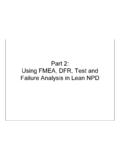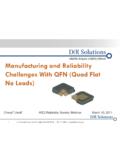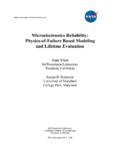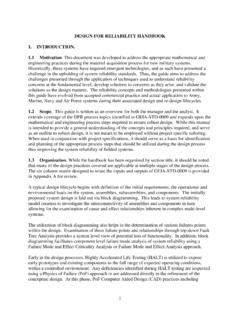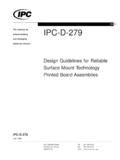Transcription of EBR-II Test and Operating Experience - Home - Arc Nuclear
1 EBR-II Test and Operating Experience Prepared for the US Nuclear Regulatory Commission John I. Sackett, INL 12/05/2008 Executive summary EBR-II operated for 30 years as a very successful test and demonstration sodium-cooled fast-reactor power plant. As a complete power plant, the reliability of the system was demonstrated and sodium Operating and maintenance technology was established. As an irradiation test facility, Oxide, Metal, Carbide and Nitride fuels were developed. Oxide fuel for the FFTF and CRBRP was qualified and Metal fuel was extensively developed for EBR-II . As an operational-safety test facility, the self-protecting response of a metal-fueled reactor was demonstrated for Anticipated Transients without Scram and the benefits to safety were quantified in a PRA. The safety of operation with breached fuel was also demonstrated. As the Integral Fast Reactor (IFR) prototype, proliferation-resistant reprocessing and recycle of fuel was demonstrated and fuel containing minor actinides was fabricated and irradiated.
2 When decommissioned, draining and reaction of the sodium to produce an acceptable form for disposal was accomplished, including passivation of residual sodium. Waste forms for geologic storage of waste from fuel reprocessing were developed and qualified. The EBR-II Experience and test program has established the viability of sodium-cooled fast reactor power plants. Introduction There is an important partnership between fast and thermal reactors because fast-spectrum reactors can burn as fuel the waste that thermal reactors produce (primarily long-lived minor actinides). Studies have indicated that anywhere from 10% to 20% of the fleet should be fast reactors to effectively manage this waste depending on the rate of growth of Nuclear deployment. Further, fast reactors can greatly extend the fuel supply (approaching a factor of 100). Extending fuel supply was the promise of fast-reactor development at the dawn of the Nuclear age. EBR-I, a fast-reactor, was the first reactor in the world to produce electricity (December of 1951).
3 EBR-II then followed, producing power in 1964 and Operating for 30 years as a complete power plant. Based on this and extensive international Experience , the technology has been shown to be successful. International Experience Fast reactor Experience is extensive. Fast Reactors have been operated in the US, France, UK, Germany, Japan, India and Russia. In each of these countries, small reactors of similar size to EBR-II were operated to develop and test the technology. These early test reactors were, EBR-II (US), Rapsodie, (France), DFR (UK), KNK (Germany), JOYO (Japan), and BOR-60 (Russia). Of these, EBR-II , KNK, DFR were complete power plants. In the US and Russia, small, specialized fast-spectrum test reactors were operated to address questions of physics, SEFOR and EBR-I (US), and BR-2, BR-5/BR-10 (Russia). The next generation of fast reactors was made up primarily of complete power plants that incrementally increased power levels over the test reactors that preceded them.
4 These reactors were Fermi-1 (US), PHENIX (France), PFR (UK), SNR-300 (Germany), MONJU (Japan) and BN-350 (Russia). France and Russia operated larger commercial plants, Super-PHENIX (France) and BN-600 (Russia). In addition the US constructed and operated a second research reactor FFTF, (but without an electricity generating system). The US also pursed design of the CRBRP, which was cancelled before construction was completed. A similar fate befell the German fast reactor, SNR-300. All of these reactors were/are cooled with sodium. Sodium supports a fast-neutron spectrum because of low neutron moderation and absorption. It has excellent thermal conductivity and high heat capacity, which allows for high power density in the core. Its relatively low density reduces pumping power requirements and its large margin to boiling allows for operation at atmospheric pressure. The coolant is also chemically compatible with structural materials, which minimizes corrosion in plant cooling systems.
5 However, an inert atmosphere covering the sodium is needed because it is reactive with air. Sodium at temperature will burn if exposed to air and special fire-suppression systems are an important part of design. International Fast Reactor Experience Reactor Country Dates of Operation Power (MWt)EBR-I US 1951-1963 EBR-II US 1964-1994 Fermi-1 US 1963-1972 200 FFTF US 1980-1992 400 CRBRP US Cancelled (1983) 975 Rapsodie France 1967-1983 40 Phenix France 1973- 563 Superphenix France 1985-1997 3000 BR-5/BR/10 Russia 1958-2002 8 BOR-60 Russia 1968- 60 BN-350 Russia 1972-1999 1000 BN-600 Russia 1980- 1470 JOYO Japan 1982- 140 MONJU Japan 1980-1992 714 DFR UK 1959-1977 72 PFR UK 1974-1994 600 KNK-II Germany 1972-1991 58 FBTR India 1985- Sodium-cooled reactor Operating Experience is extensive and has resulted in the
6 Following major conclusions: Positives: Fast reactor fuel is reliable and safe, whether metal or oxide. Cladding failure does not lead to progressive fuel failure during normal or off-normal reactor operation. High burnup of fast reactor fuel is achievable, whether metal or oxide. Acceptable conversion ratios (either as breeders or burners) are also achievable with either fuel type. Sodium is not corrosive to stainless steel or components immersed within it. Leakage in steam generating system with resultant sodium-water reactors does not lead to serious safety problems. Such reactions are not catastrophic, as previously believed, and can be detected, contained and isolated. Leakage of high-temperature sodium coolant, leading to a sodium fire, is not catastrophic and can be contained, suppressed and extinguished. There have been no injuries from sodium leakage and fire (operation at near atmospheric pressure is an advantage to safety). Fast-Reactors can be self-protecting against Anticipated Transients without Scram when fueled with metal fuel.
7 Load-following is also straightforward. Passive transition to natural convective core-cooing and passive rejection of decay heat has been demonstrated. Reliable control and safety-system response has been demonstrated. Effective systems for purity control of sodium and cleanup have been demonstrated. Efficient reprocessing of metal fuel, including remote fabrication, has been demonstrated. Low radiation exposures are the norm for Operating and plant maintenance personnel, less than 10% of that typical for LWRs. Emissions are quite low, in part because sodium reacts chemically with many fission products if fuel cladding is breached. Maintenance and repair techniques are well developed and straightforward. Electromagnetic pumps operate reliably.. Negatives: Steam generators have not been reliable and are expensive to design and fabricate. Sodium heat-transport systems have experienced a significant number of leaks because of poor quality control and difficulty with welds.
8 Also, because of sodium s high thermal conductivity, many designs did not adequately anticipate the potential for high thermal stress on transients. Many problems with handling fuel in sodium systems have occurred, primarily because of the inability to visually monitor operations. Failure of in-sodium components without adequate means for removal and repair has resulted in costly and time-consuming recovery. Sodium-cooled fast reactors have been more expensive than water-cooled-reactor systems. Reactivity anomalies have occurred in a number of fast reactors, requiring careful attention to core restraint systems and potential for gas entrainment in sodium flowing through the core. Operational problems have been encountered at the sodium/cover-gas interface, resulting from formation of sodium-oxide that can lead to binding of rotating machinery, control-rod drives and contamination of the sodium coolant. EBR-II Design Description: keys for success EBR-II suffered few of the negatives and was able to develop technology that led to success of plants to follow.
9 The reason for this success was based on design choices, attention to details of construction, disciplined operation and maintenance, and an aggressive test program that developed a deeper understanding of the technology. EBR-II was a complete power plant, producing 20 MWe with a conventional steam-turbine (with superheat). The reactor produced MWt. EBR-II Operating Parameters Power Output, thermal Power Output, electric 20 MWe Reactor Inlet Temperature 700 F Reactor Outlet Temperature 883 F Flow-rate Through Core 9,000 gpm Volume of Primary Sodium 89,000 gal Sodium Temperature to Superheaters 866 F Sodium Temperature from evaporators 588 F Steam Temperature 820 F Steam Pressure 1,250 psig Feedwater Temperature 550 F Fuel Metal 63% enrichedPrimary System Configuration Piped Pool Steam Generator Design Duplex Tube EBR-II was a Complete Power Plant EBR-II was a sodium-cooled reactor with a piped-pool configuration. That is, the coolant was drawn from a tank of sodium by two centrifugal pumps and then piped to a plenum at the bottom of the core.
10 The sodium, after flowing through the core, was then piped to an intermediate heat exchanger where heat was transferred to the secondary sodium system. This configuration allowed for leakage at the connections at the outlet of the pumps and at the intermediate heat exchanger, since primary sodium would simply leak back to the tank from which it was drawn. This also allowed for ball and socket connections at the pumps which facilitated their removal and replacement. The tank, which was a right circular cylinder, was maintained at a nearly uniform and constant temperature (700F), which limited thermal stress. Another important feature was that the tank included no penetrations through the wall; all penetrations were through the top. This also limited the risk for thermal stress, weld failure and sodium leakage. A guard tank surrounded the primary tank with an annulus between them which allowed for detection of sodium leakage. The guard tank was in turn surrounded by concrete shielding which acted as a final containment vessel.
